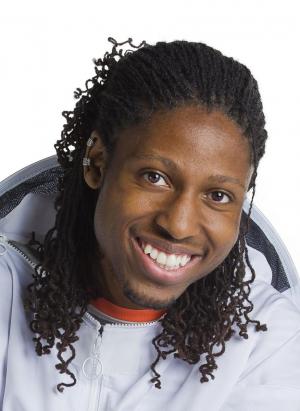University of Maryland doctoral candidate Samuel Ramsey has wanted to be an entomologist since he was seven years old, but his first introduction to insects had a less than auspicious beginning.
 “I was initially terrified of insects,” says Ramsey, a native of Temple Hills, Maryland, “My parents didn’t like that I had such an irrational fear that was beginning to have a negative impact on my life.” To combat this fear, they sent him to the library, hoping that more knowledge would alleviate his phobia.
“I was initially terrified of insects,” says Ramsey, a native of Temple Hills, Maryland, “My parents didn’t like that I had such an irrational fear that was beginning to have a negative impact on my life.” To combat this fear, they sent him to the library, hoping that more knowledge would alleviate his phobia.
Ramsey has come a long way since then—not only is he about to complete a doctorate in entomology, but he is representing UMD and the Graduate School at the international Three Minute Thesis contest. In this contest, sponsored by Universitas 21, an international network of research universities, contestants are judged on their ability to communicate the significance of their research to an educated lay audience in just three minutes. Contestants are competing for three prizes: Judges’ First Place, Judges' Highly Commended, and People's Choice, which is decided by online popular vote.
Ramsey’s research is on a tiny parasitic mite, Varroa destructor, which is the single biggest contributor to the decline in health of honey populations worldwide. Originating in Asia, the invasive Varroa mite is wreaking havoc on honey bee colonies, both by feeding on adult and immature bees and by serving as a vector for five debilitating viruses.
For nearly 50 years, researchers have believed that the mite fed on the hemolymph (the “blood”) of the honey bee. Ramsey has done extensive research on the feeding habits and nutrition of the Varroa mite that provides strong evidence that this model is incorrect, and that current methods of controlling the parasite are not only ineffective, but may contribute to pesticide resistance.
Ramsey’s research establishes that the mites are primarily feeding on the honey bee’s fat body tissue—an organ in insects that serves a similar role to the human liver. Since several existing systemic pesticides were formulated assuming the mites fed on hemolymph, this discover explains why these pesticides were never successful in controlling the mites. The mites never would have ingested enough to kill them, but this frequent exposure may contribute to future resistance. Ramsey’s work also explains why honey bees suffer so many negative consequences from a parasite we believed was only consuming a small amount of their blood. His discovery will enable researchers to develop more targeted control techniques that could help restore honey bee populations worldwide.
University of Maryland students have a highly successful track record in the 3MT contest. In 2015, University of Maryland representative, Carly Muletz Wolz, a doctoral candidate in biological sciences, won the People’s Choice award. In 2014, the first year that UMD entered the competition, Amy Marquardt, who completed her PhD in material science and engineering, won both the Judges’ First Place and People’s Choice awards.
Ramsey is no novice to communicating his research to a lay audience. He is passionate about educating non-scientists about insects, especially his beloved pollinators. He is an in-demand speaker for beekeeping club meetings across the country, and posts educational videos on YouTube under the name Doctor Buggs.
“I’m passionate about bridging the gap between researchers and non-scientists, especially aspiring scientists,” he says. “Insects are the coolest thing you’ve ever stepped on.”
To learn more about the contest, and to vote, visit: www.u213mt.com.
Photo: John Consoli/University of Maryland
